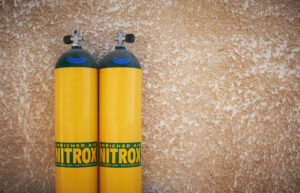What is a Depth Gauge?
A depth gauge is a crucial piece of scuba diving equipment that measures and displays a diver’s depth below the water’s surface. Its accuracy and reliability are essential for maintaining diver safety, calculating decompression stops, and monitoring dive profiles. As scuba diving has evolved, so too have depth gauges, with modern devices offering digital displays, enhanced accuracy, and additional features to improve the diving experience.
Historical Overview
The history of depth gauges can be traced back to the 17th century when French scientist, mathematician, and philosopher Blaise Pascal developed the first barometer. Pascal’s barometer, which measured atmospheric pressure, laid the groundwork for the development of depth gauges as we know them today. The first depth gauges utilized in diving were simple devices that relied on a diaphragm or Bourdon tube, converting water pressure into a mechanical movement to provide depth readings.
Types of Depth Gauges
There are two main types of depth gauges: analog and digital.
Analog Depth Gauges
Analog depth gauges are the traditional type of depth measurement devices, using a diaphragm or Bourdon tube mechanism. Water pressure causes the diaphragm to expand or the Bourdon tube to bend, which in turn moves a needle across a calibrated scale to indicate the diver’s depth. Analog depth gauges are available as standalone devices or integrated into a console alongside other essential instruments like a submersible pressure gauge (SPG) and compass.
Advantages of analog depth gauges include their simplicity, ease of use, and reliability. They often require less maintenance and are less susceptible to electronic failures. However, they tend to be less accurate than digital depth gauges, especially at deeper depths.
Digital Depth Gauges
Digital depth gauges use electronic sensors to measure water pressure and calculate a diver’s depth. They display the depth on a digital screen, either as a standalone device or as part of a dive computer. Digital depth gauges offer several advantages over analog gauges, including greater accuracy, the ability to display depth in smaller increments, and additional features such as ascent rate monitoring and temperature readings.
While digital depth gauges offer many benefits, they also come with some drawbacks. They rely on batteries and electronic components, which can fail or require maintenance. Additionally, they can be more expensive than their analog counterparts.
Depth Gauge Features
Modern depth gauges offer a range of features to enhance diver safety and convenience. Some of these features include:
- Maximum Depth Indicator: This feature records the maximum depth reached during a dive, providing essential information for logging and decompression planning.
- Ascent Rate Indicator: Rapid ascents can be dangerous for divers, leading to decompression sickness or barotrauma. An ascent rate indicator helps divers maintain a safe ascent speed, typically between 18-30 meters/minute (60-100 feet/minute).
- Depth Alarms: Some digital depth gauges allow divers to set depth alarms, alerting them when they reach or exceed a predetermined depth.
- Temperature Sensor: A built-in temperature sensor can provide valuable information about water temperature, which affects factors like dive duration, wetsuit selection, and decompression planning.
- Backlit Display: A backlit display enhances readability in low-light conditions, making it easier for divers to monitor their depth.
- Nitrox Compatibility: For divers using enriched air nitrox (EANx), a nitrox-compatible depth gauge is essential to ensure accurate depth readings and safe diving practices.
Depth Gauge Maintenance
Proper care and maintenance of a depth gauge are vital to ensure its accuracy and longevity. Divers should rinse their depth gauge with fresh water after every dive to remove salt, sand, and other debris. They should also store
the depth gauge in a dry and cool place, away from direct sunlight, to prevent damage to sensitive components. Periodic servicing by a qualified technician is also recommended to maintain optimal performance.
For analog depth gauges, it is crucial to inspect the diaphragm or Bourdon tube for signs of wear or damage, as this could compromise the device’s accuracy. Digital depth gauges, on the other hand, should have their batteries checked and replaced regularly to ensure consistent performance.
Choosing the Right Depth Gauge
Selecting the right depth gauge depends on several factors, including the diver’s experience level, diving conditions, and personal preferences. Here are some considerations when choosing a depth gauge:
- Experience Level: Beginner divers may prefer an analog depth gauge due to its simplicity and ease of use, while more experienced divers might opt for a digital depth gauge for its added features and greater accuracy.
- Diving Conditions: Divers who frequently dive in low-visibility or low-light conditions may benefit from a depth gauge with a backlit display for better readability.
- Integration: Some divers prefer a streamlined setup with a depth gauge integrated into a console or dive computer, while others may opt for a standalone device.
- Price: Analog depth gauges are generally more affordable than digital models, so budget may be a consideration for some divers.
- Additional Features: Divers who regularly dive with nitrox or those who desire specific features like ascent rate monitoring or depth alarms should factor these into their decision.
Key Takeaways
A depth gauge is an essential piece of scuba diving equipment that plays a critical role in diver safety and dive planning. With a range of options available, from traditional analog gauges to advanced digital models, divers can choose the depth gauge that best suits their needs and experience level. Proper care, maintenance, and regular servicing of a depth gauge will ensure its accuracy, reliability, and longevity, contributing to a safe and enjoyable diving experience.
















